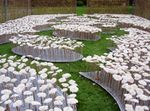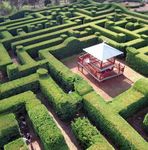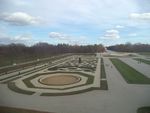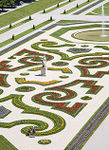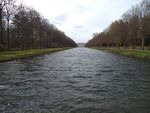Planting Design 2013 Working Group 15 - Case Study C
---> back to group page working group 15
Please add the title of your case study here, adjust the map coordinates and replace the moa image with a characteristic image of your site
| Name | Schleissheim Garden | |
| Location | Oberschleissheim | |
| Country | Germany | |
| Authors | Tilak Nagaraju | |
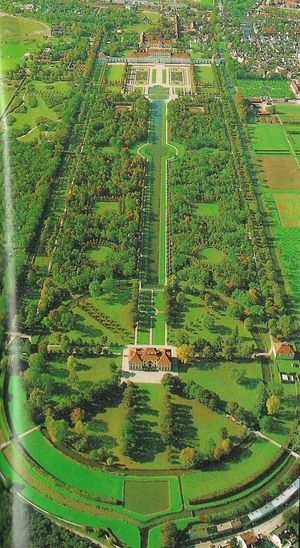
| ||
|
| ||
Rationale: Why is this case interesting?
Schleissheim is one of the few Baroque Gardens, which have been preserved in their original layout since it was completed in 17th century.
- Dominique Girard was the French Garden Architect who worked on the designs of the garden parterre (flat, low planted area) and modernization of the boskett (woods, thicket).
- Landscape of the Baroque garden is a mixture of symmetrical, geometrical and ornamental patterns covered with different kind of flowers and plants. Artistic and dramatic landscapes are achieved in Baroque design.
- The gardens are really splendid, beautiful and natural. The parks and blooming flowers stand for freshness and life, for a sound environment and an easy going way of life. People irrespective of ages would love to walk in this garden at all times.
Author's perspective
I am documenting this case on professional background as a Civil Engineer. With respect to my perspective to save/preserve the old styles of gardening which is important to save the cultural features, history of the city and to keep our environment and surroundings with more of green nature.Cultivating Green image requires not only professional experience but also adequate material.It is also necessary to reconcile the diverging concerns of ecology,environment protection,species and plant protection and landscape.
Landscape and/or urban context of your case
Munich has 904 municipal green areas covering altogether 1,718.52 hectares, including 467 playgrounds and ball-playing fields. There are 727.76 hectares of state controlled parks and gardens which are maintained by “Bavarian Administration of State Palaces, Gardens and Lakes”. The green areas thus total more than 2,446.28 hectares, meaning that every citizen in Munich has 19 sq.m of green area for his personal use. If we add the semi-public green areas and two municipal recreational areas outside the city limits the total increases to 4600 hectares, so that in the end every munich citizen is the proud owner of 34 sq.m of parks and gardens.
- The Schleißheim Garden with its surrounding canals and the large bosket area between Lustheim and the New Palace was designed from 1684 by Henrico Zucalli when Lustheim Palace was built.
- Parterre was built at a lower level, with large ornamental beds, sculptures and a magnificent cascade. The central axis around which the entire garden was aligned first served as an alley for the popular court game of pall mall, and at the end of the 18th century was turned into a canal.
- Both residences were connected by a system of canals which feed the fountains, but also serving as a transport network, for instance, to carry construction materials to Schleissheim The canals were built by Dutch engineers and are a masterpiece of engineering with water being taken from the small river in the western part of the Munich Plain, then led two times across the plain to be finally discharged again into the river Additionally, water could be fed into the system from smaller streams. Most of the canals still exists today. Other historically important visual axes are not existent any more, but some can perhaps be recuperated by inter municipal planning.
Analytical drawings
Maintaining a baroque garden can be very demanding, as the hedges, flower beds, and the trees should always have constant pruning to maintain their shape and watering to retain their vibrant colors. Fountains, small ponds, and waterfalls should also be regularly cleaned. Not only is the maintenance of a baroque garden challenging, it can also be very expensive. Acquisition of statues and construction of artificial ponds and waterfalls alone cost a lot of money, not to mention supplying the whole garden with water and hiring several workers to maintain the garden. Having baroque gardens is a symbol of wealth, social status, sophistication and elegant taste.
- Analytical Drawings
- Yourfilename2.jpg
analytical drawing 2
- Yourfilename3.jpg
analytical drawing 3
- Yourfilename4.jpg
analytical drawing 4
Projective drawings
Planting tall plant hedges that give the garden its structured design. These hedges could reach the height of an average person’s waist, or even be taller than a person, making guests feel like they are walking through a maze. Enclosed in the hedges could be flower beds, statues, or uniformly-shaped trees that give the garden little bursts of variety in height and shapes. Benches and smaller gazebos can also be contained inside the hedges, to give the garden some functionality as a meeting place or as a private sanctuary. At times, the flowers themselves would be the hedges, giving the garden a colorful outline amongst the green background of the grass.
- Projective Drawings
Summary
A baroque garden is a type of garden that is designed using geometric shapes, usually circles, rectangles, and triangles. It can also be designed with irregular patterns made of swirls and curved lines, so that when the garden is viewed from the top, it can look like a larger-than-life maze or an emblem. Baroque gardens usually require large areas of land that can accommodate their artistic and dramatic landscapes.The popularity of baroque gardens came about in France from the 15th and 16th centuries, although the concept behind the garden originated from Italy during its Renaissance period, when the fields of science and mathematics experienced much progress. The basic principal behind a baroque garden is hugely attributed to the theories of Renée Descartes, specifically the theory that the infinite space can be divided in finite parts. Symmetry was also an important element in baroque gardens, but this does not limit the design in having elaborate patterns.
Conclusion
- Gardens can be considered as a Learning Resource Centre with live examples. It is an exploratory centre to facilitate the free flow of qualitative and quantitative information on all types of plants including economic plants.
- Moreover it is a Learning laboratory that provides a framework for training in Horticulture and landscape architecture. Thus gardens can be considered as the Second biggest classroom in nature.Success depends on the unique combination of facilities, opportunities, expertise and the link with other gardens.
- Moreover modern gardens have a role in society with new and extremely important elements in it. These include the "ex situ" maintenance of rare and Endangered species cultivation.
- Considerable research effort is needed in order to develop techniques to deal with the complex ecological relationships relevant to most environmental problems.
Image Gallery
You may add a series of images/photos in addition to the sketches/drawings
- Image Gallery
References
* Please make sure that you give proper references of all external resources used.
* Do not use images of which you do not hold the copyright.
* Please add internet links to other resources if necessary.
About categories: You can add more categories with this tag: "", add your categories

